Svalbard, a fast – changing world
My next journey with the untamed starts between the 74 ° and 81° North in an increasingly popular destination for polar enthusiasts: Svalbard !
« Svalbard » or « cold edge », as it literally translates to, is said to have been discovered by the Vikings in the 12th century. Yet during most of the history of the archipelago, the Dutch name Spitsbergen has been in use, the land of the « pointed mountains ». In Hornsund, the southernmost fjord on the main island, you can start getting a feel for this landscape. As you sail deeper into the fjord, a corridor of impressive peaks and glaciers escorts you along. I often surprise myself thinking this visit to Hornsund is like paying the compulsory visit to the local gods to make sure our sailing journey around the archipelago will be a safe one !
This year, I arrived in Svalbard in July, which is now considered a bit late in the breeding season for most of the arctic wildlife. The natural cycles are being increasingly remodelled as temperatures are climbing faster here than anywhere else in the Arctic- up to seven times the global average*.
* I warmly recommend reading the book « My world is melting » by Line Nagell Ylvisåker, the story of what it means to live in Svalbard, the hot spot of climate change.
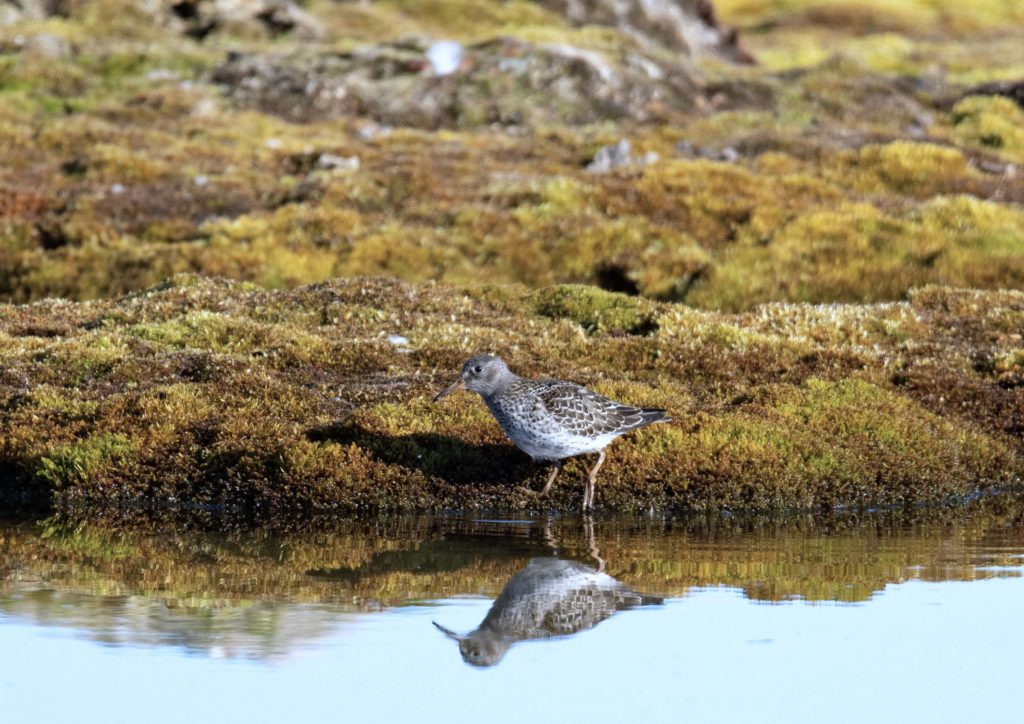
Yet, on one of our first stops on the coastal tundra, I was greeted by a pair of breeding arctic skuas – Stercocarius parasiticus– ! The light morph is very commonly seen in Svalbard and breeds anywhere in the archipelago. Despite being specialised in stealing prey from other birds, I couldn’t see any black-legged kitiwakes or guillemots- their preferred targets- close by this very day ! No acrobatic hunts in the air but long minutes spent on the ground and a rather unbalanced if not clumsy way of walking. Despite being well equipped with my SFLs, I often lost sight of them on land due to their efficient camouflage plumage. I couldn’t spot any nest or chick but I made sure to stay far enough from an area around which the birds seemed to be more active.
Can you spot the two skuas on this photo ?
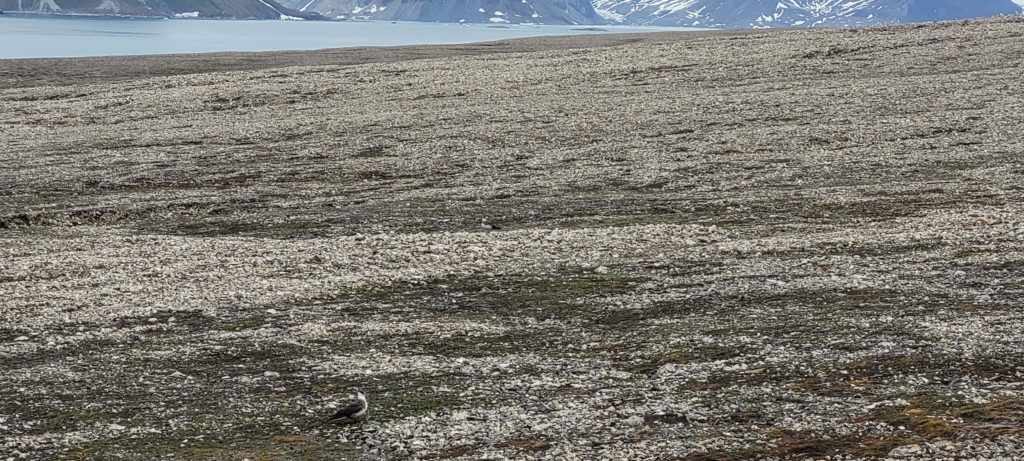
If I had escaped from the dive-bombing by the skuas and felt proud to have well-calibrated my moves on the tundra, my satisfaction was soon shattered by another very famous visitor of the great North : the Arctic tern –Sterna paradisaea- ! Despite all the admiration I feel for this incredible species that holds the record of the longest migration of all birds, I like to call them « screechers of the Arctic » – because yes, they can be VERY loud ! Especialy when it comes to protecting their nests from what they perceive as intrudors.
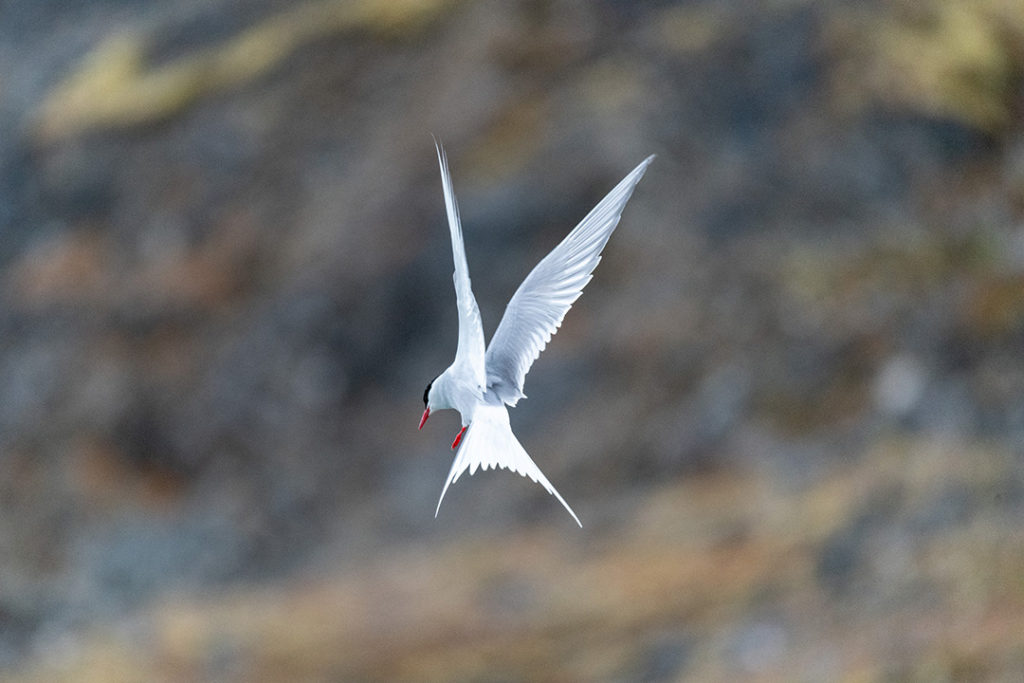
In Ny Alesund, the northernmost inhabited settlement of the Arctic, a big colony breeds there. Furious dive bombs and high-pitched calls is often what you get as soon as you start walking into the settlement. And this year, I didn’t only get dive-bombed at, but also properly soiled despite having been cautious with my moves! What a welcome !
Ny Alesund became a hotspot for international research in the 1960s. It’s one of the few places in the world where cross-disciplinary collaboration for climate research is being undertaken in the field. A friend of mine used to be one of the managers of the French-German research station there, AWIPEV, and I had to stop for a selfie in front of his former office.
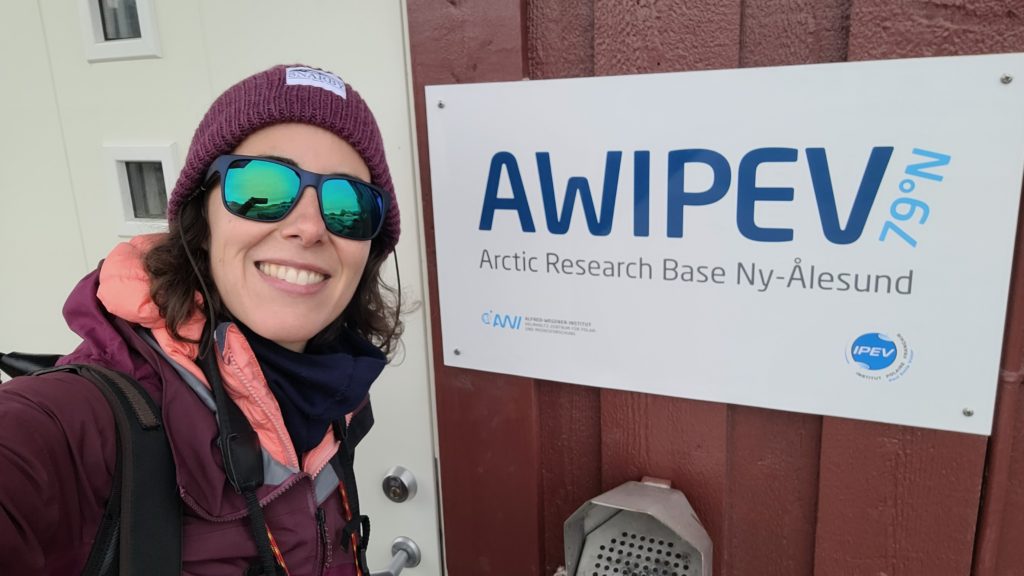
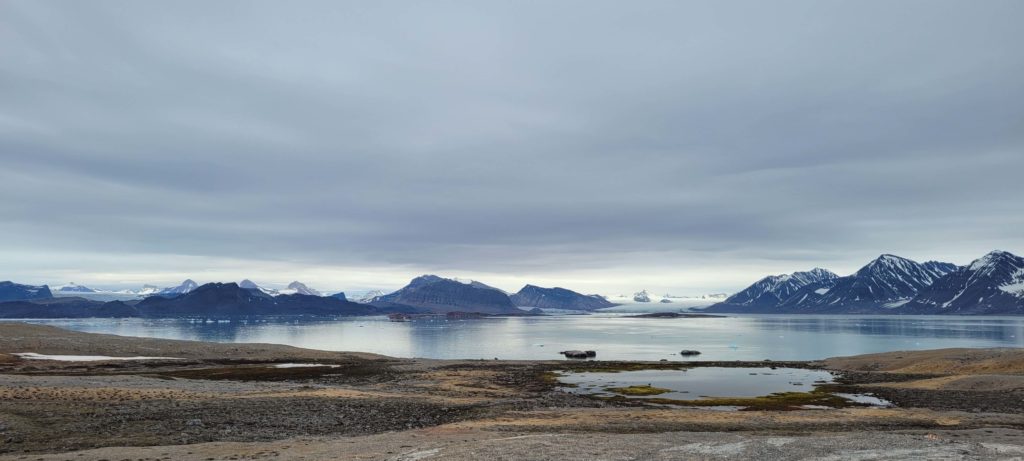
In the area, harbour seals often come to rest alongside nesting bird colonies. This has sometimes been drawing polar bears close by, and their visits have been increasing these past years. Last year, a researcher was telling me how all the barnacle geese nests monitored by the station had been destroyed – eggs eaten- by the hungry carnivores. These are hard times for scientists and wildlife alike !
Accross the bay lies another settlement initially established as a mining camp : Ny London.
From Ny London you have a wonderful panorama of the fjord and you can easily distinguish if weather permits, the three well -known pyramidal peaks called the Tre Kroner (Three crowns) ( seen here on the left background of the picture) : Svea, Dana and Nora (Sweden, Denmark, Norway) . They are emblems of the historical ties between these three countries.
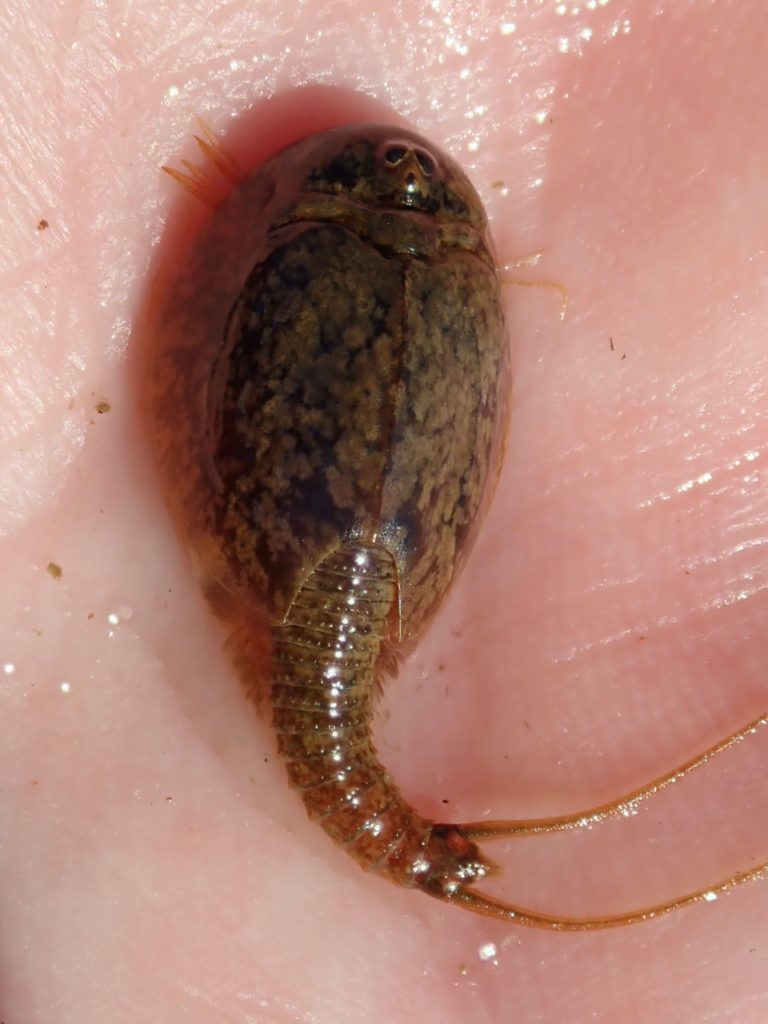
In the foreground of this incredible view, you can see a small freshwater lake. Despite being small, it has the special feature of housing the Arctic tadpole shrimp (Lepidurus arcticus) that we managed to find on its shores (See picture- A mature individual in my hand). This crustacean is a true arctic species which only thrives in extreme environments. It makes a valuable source of energy to many species of migratory birds which rest and feed close to these freshwater reservoirs. As it requires high oxygen concentration and cool water to survive, it’s often considered as a good indicator species of climate change. (On the picture below, a juvenile purple sandpiper-Calidris maritima– foraging on the shores of the lake).
On this same spot, I was excited to come upon a breeding pair of red-throated divers (Gavia stellata) ! The weather was cloudy but when these birds cross a ray of light, the touch of vivid red-brown colouring their throats is one of the most beautiful thing I’ve seen in my life. Their colour and their elegant outline suddenly bring a bit of gentleness to the sharp scenery around us.
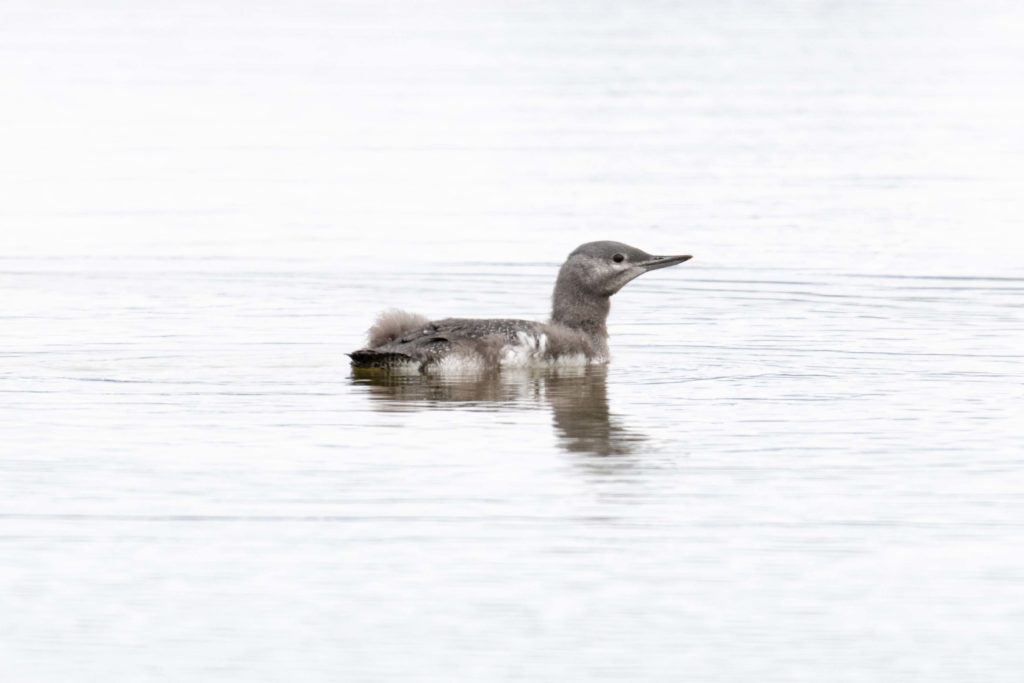
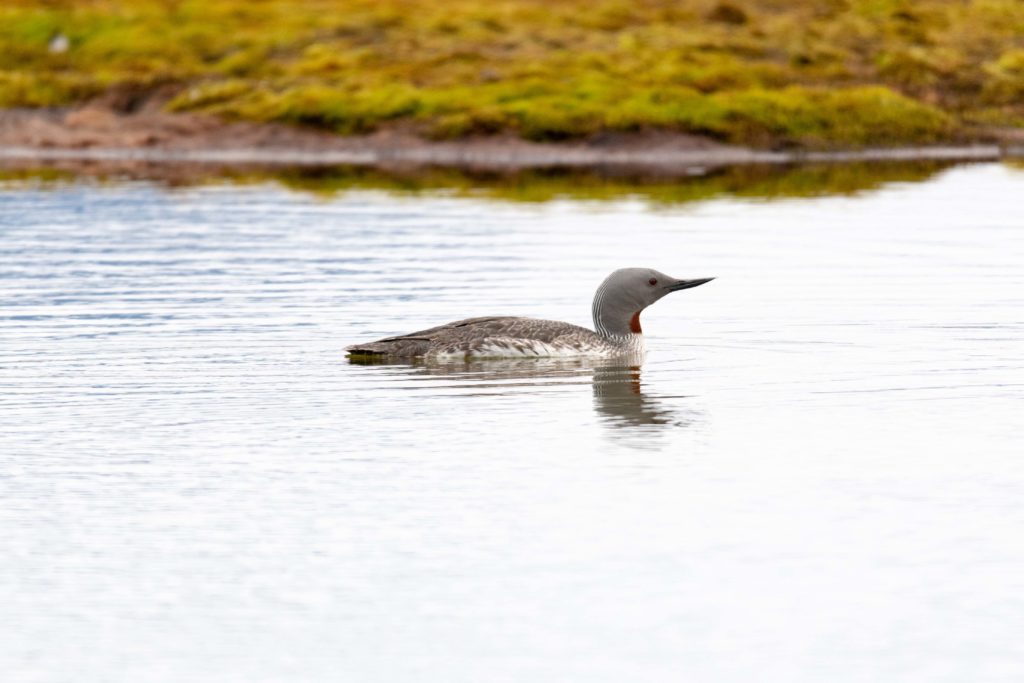
This year again , I was able to see two breeding adults and their young, peacefully swimming on the lake. Were they the same couple that I observed last year, returning to the same nest ? I didn’t have the answer. But it made me feel good to imagine it was them 😊
We had been warned that a bear had been seen in the area two days ago. My colleagues and I were on the look-out. Landing in Svalbard asks for a lot professionalism and vigilance. Behind our smiles and relaxed ways in front of the guests, our team is always on alert. We rotate positions and while some of us take care of the guests, others do bear protection, equipped with binos, a flare gun and a rifle (see picture : Me on polar bear protection duty with the SFLs in hand!)
But this day, the large carnivore didn’t show up. And in a way, I was happy with that. We had been blessed by this beautiful sightings and had already been fully rewarded for coming this far north !
The next day, we headed to the pack ice. The ship would sail along the ice edge for the day and we would be stationned at the bridge to look for wildlife. This is one of the moments of the cruise that I appreciate the most.
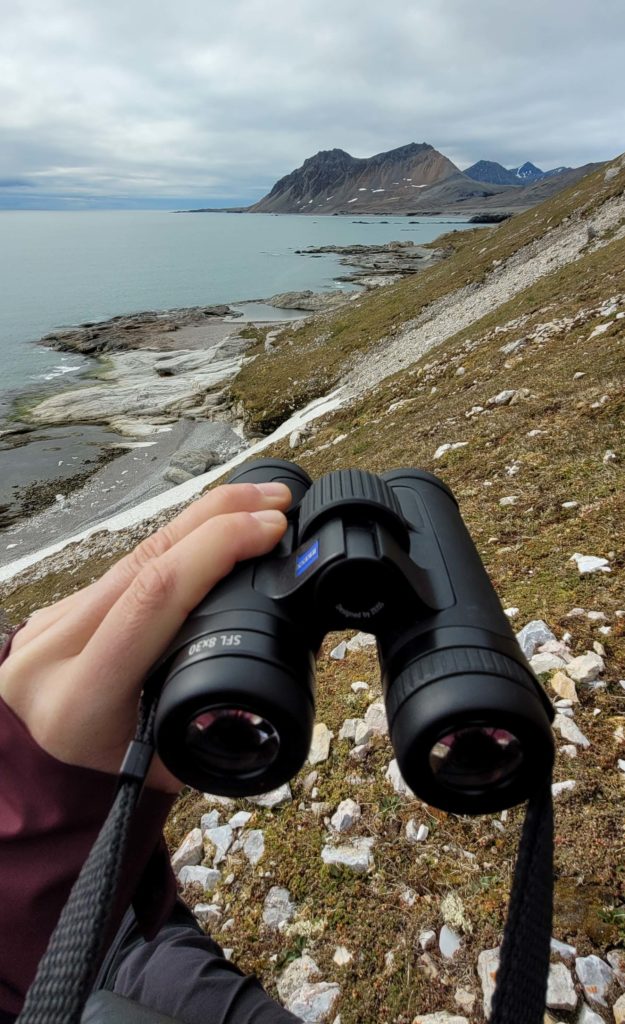
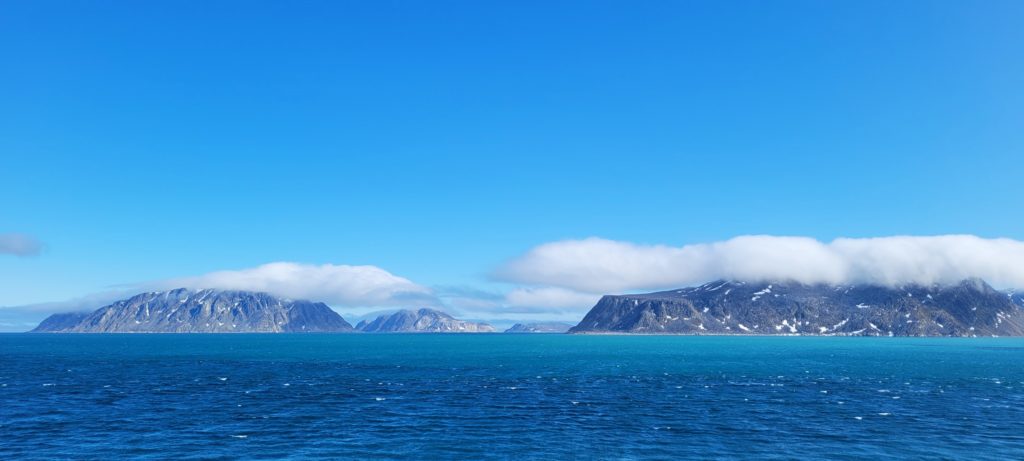
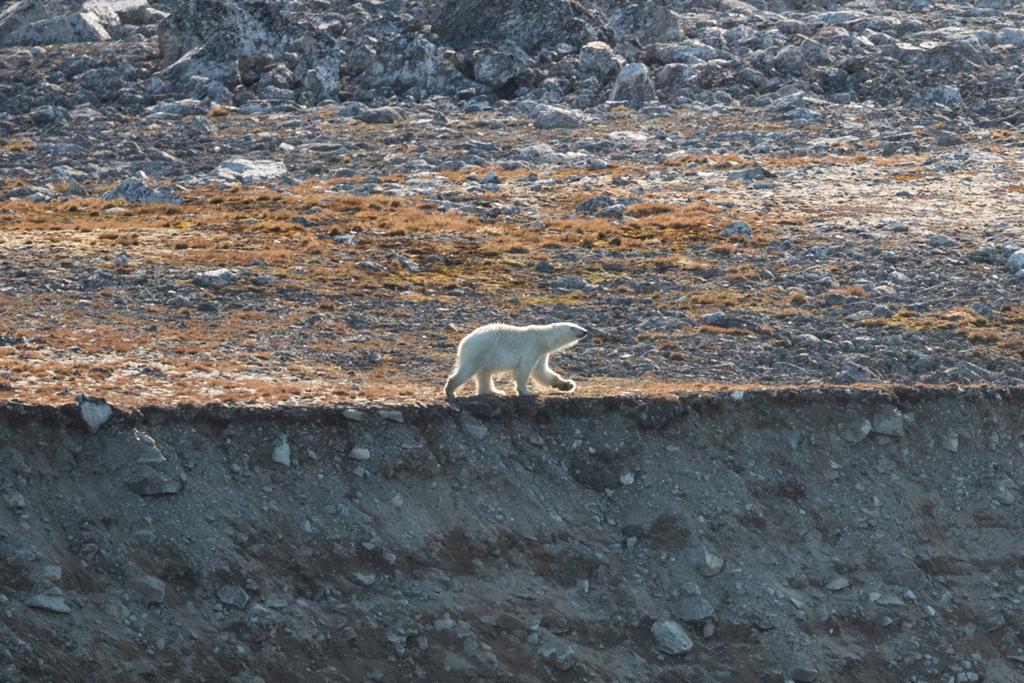
Yet, as we were leaving the main island, eyes glued to our binos and mine to my SFLs, I spotted a whitish form on the shoreline. No hesitation possible ! It was too big to be a reindeer, too white to be a rock, and as we got closer to the shore, we knew what it was : a polar bear (Ursus maritimus)! A young adult male more exactly. Walking hastefully on a track, nose up. It was smelling something ! Carrion ? At this time of the year, a carrion would drag many bears around. The bears are hungry and struggling to find food. Did we miss any information about that ?
In a matter of a few seconds, we found the answer ! A large female with her cub were seen running in the opposite direction of the male bear. The male had probably come to mate, and there were high risks that to do so it would initially kill the actual cub of the female. She knew it and she was escaping. Within a few minutes she had disappeared behind the mountain, climbed its slopes and entered the mountain pass. The male bear turned around.
We couldn’t have hoped for such an emblematic, yet intense scene unrolling in front of our eyes. It had been a real privilege to be able to witness that behaviour. And I couldn’t help myself from feeling anxious about the future of these animals in the years to come.
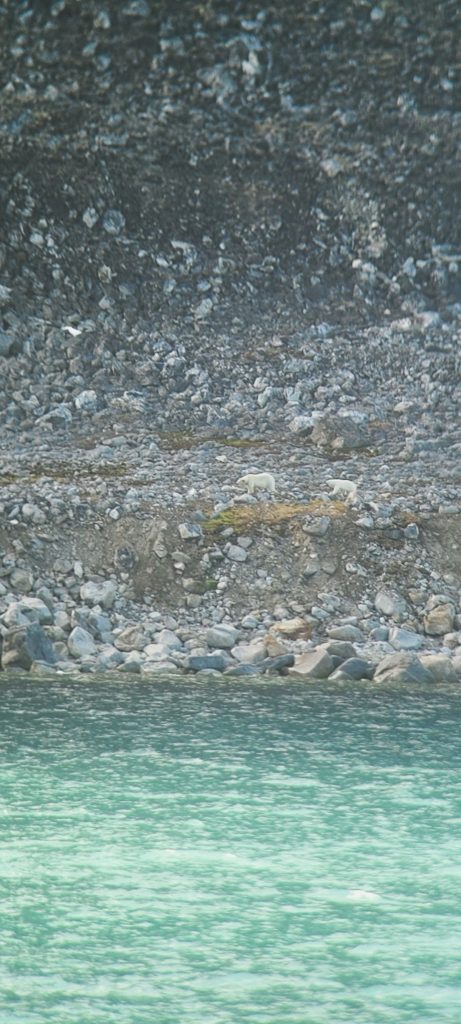
We woke up in a rather open pack ice the next day. The sky was deep blue and the sun was shining brightly. The sea was calm, no wind and just a very smooth swell. We were in the perfect conditions for easy wildlife observation. As we moved away from the ship in our zodiacs, a big brownish clump seemed to lay on an ice floe quite far away. Ice colouration ? Bearded seal ? Walrus ? We wanted to have a closer look. As we got nearer, the mass slowly took shape and it clearly was not a bearded seal.
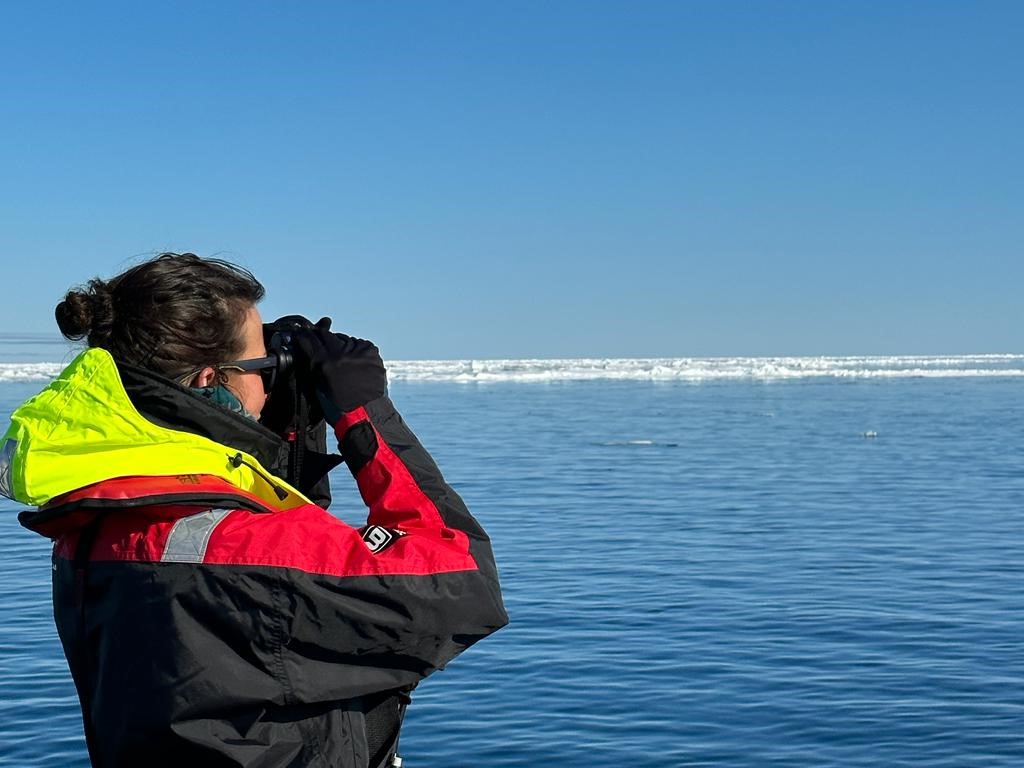
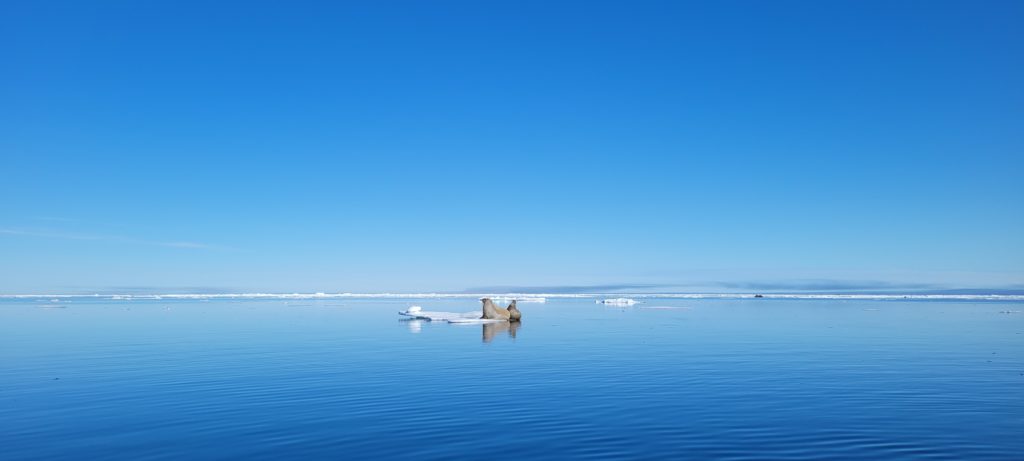
We identified not one but two walruses (Odobenus rosmarus rosmarus), hauled over an ice floe ! One was older than the other, as the size and the length of the tusks showed. The sexual dimorphism in walrus is not something easy to spot for a non-expert eye.
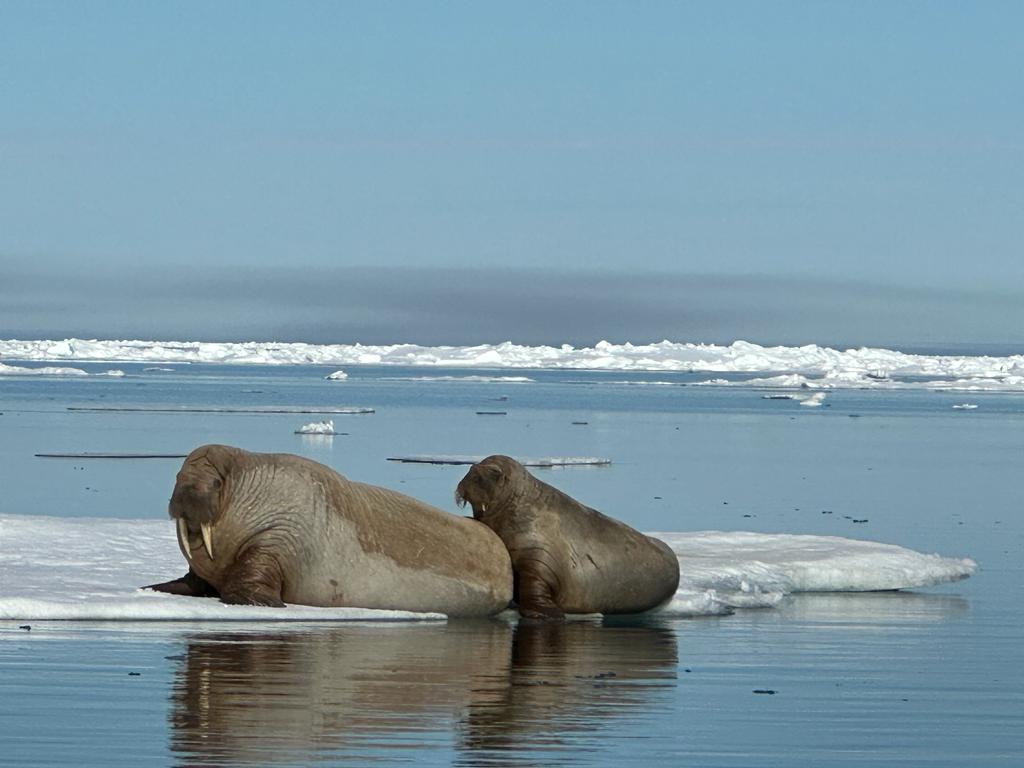
The smaller walrus seemed to be a young male between 2-3 years old as the length and the shape of his tusks seemed to show. The bigger one looked like a female aged 6-9 years old. The female could have been the mother of the young male. And if that was the case, it would be mean the male would be her first calf as Atlantic walruses are sexually mature around 6 years old and usually give birth to a new calf every 3 years.
Putting the maths aside, you see from the picture that the walruses were looking towards our direction. Indeed, a third walrus coming from our side swimming towards them, was making very loud guttural sounds. It tried to climb on the ice floe a few times but failed.
We left these big pinnipeds to their own devices and moved on with the rest of our activities for the day.
Closing the chapter of my adventures in Svalbard, I can’t thank Zeiss enough for their support and involvement in my work as a guide. By providing my with the great SFL 8*30, I was able to perform my duties in total safety and excelled in spotting wildlife !
I hope that my next sailing season will bring other great encounters with the untamed that I will be happy to share with the Zeiss community and the rest of the world !
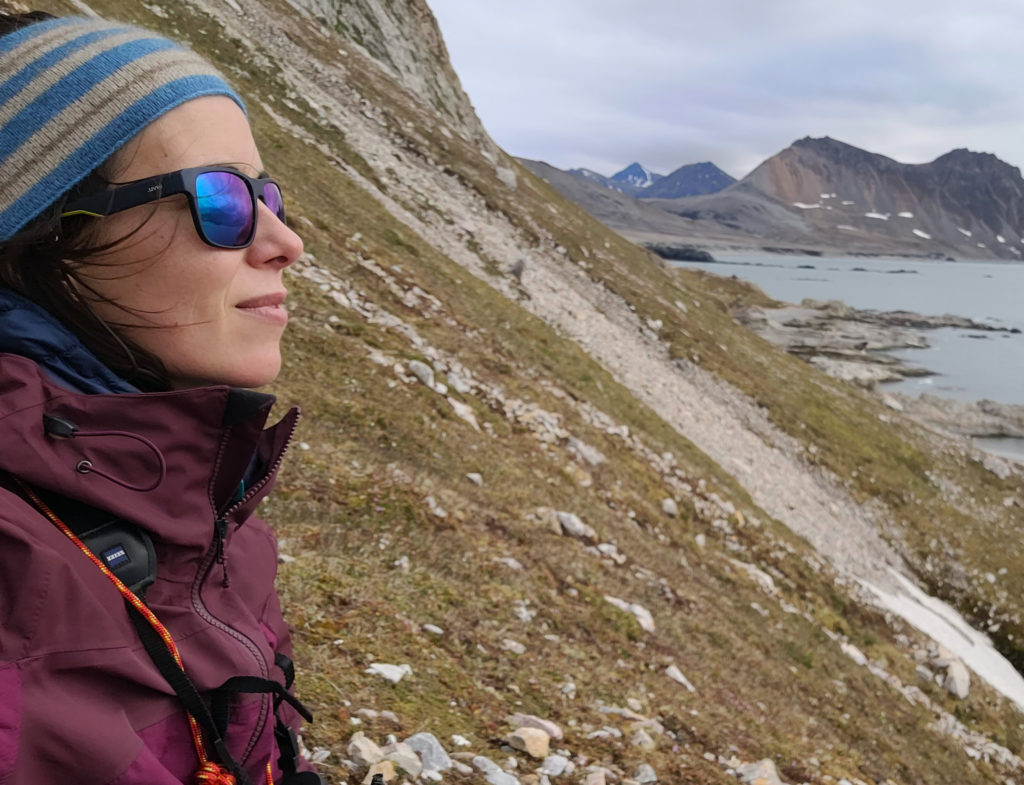
Closing the chapter of my adventures in Svalbard, I can’t thank Zeiss enough for their support and involvement in my work as a guide. By providing my with the great SFL 8*30, I was able to perform my duties in total safety and excelled in spotting wildlife !
I hope that my next sailing season will bring other great encounters with the untamed that I will be happy to share with the Zeiss community and the rest of the world !